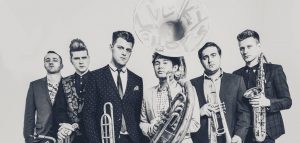
Original Funky Town from the 1980’s
It was a Friday night heading downtown as I was transferring to a different train. I overheard a live music performance. I follow the sound and found the live performance group. The group was performing on the upper level of the 34th Street–Herald Square. Infuse with the crowded and train noises the group perform a higher pitch. The logic allows the instrument pierce through the ambient sounds. Their name is Lucky Chops and they are a brass instruments group. Chops consist of tuba, trombone, trumpet, tenor saxophones, baritone saxophones, and drummer. The group was performing a cover of Funkytown by Lipps Inc compose in the 1980s. The original song instrument was hi-hat cymbal, electronic guitar and majorities were digital interface sounds. The transition from original instrument to brass group and 1 drummer was astounding. The group did not use distinctive instruments from the original track. However, was able to still perform distinctively to the original. The baritone saxophones player started out solo with repeated melodies. Soon after it was joined by the other. The drummer serves as a drone melody. While the trumpet has the most distinctive sound because it has a higher pitch. The tuba, trombone, tenor saxophones, and baritone saxophones synchronize with each other as they play repeated melodies. Proceeded by distinctive high pitch sound of the trumpet. The baritone saxophones player went back to a quick solo which provided a bass sound. As he played he is dancing to each of the notes. Doctor B from my chorus class inform me that performer from vocalist to wind-related instrument utilize several of body movement to produce more sound rather than just standing still. The baritone saxophones not only entertain the audiences with his in sync dancing. He was able to produce more wind force from his lungs. At 1:10 Tenor saxophones player call out “Here we go, 1,2,3” which signal the group to fuege the chorus. Tenor saxophones is very distinctive during chorus because of assorts of melodies. The melodies range from low to high pitch notes. The notes seem to transition from sixteen notes to whole notes. The music transitional at the 2:00 time mark. It forefront the tenor saxophones and baritone saxophones playing a 3 noted repeated melodies. While the drummer played hi-hat along with each notes of the saxophones. At the 2:16 mark the band played a called and responds styles. The trumpet would play alternating melody at a high pitch. While on the second beat the saxophones would ostinato. I would consider this piece to be ternary form because I hear 3 distinctive talea. Not only has the performance sounded live because it was played in front of me but the location of the station provided reverb. The reverb allows notes to be more sustaining and constant. In the video, it shows the band transition into another piece. However, during my event the group stops after Funky Town. Overall, it was a great learning experience. I was able to hear a brass band converting a non-piece into brass band format. The group was able to utilize the original motif and replicate it with brass instruments that are recognizable to the audience. Hearing music is one thing but seeing a live performance is another thing. I was able to see the performance in synch with the music. They were moving their feet and body to each down or up beats. Theatrically people that often vibe with their piece are comfortable with it or practice extensively. Each performance was not stiff and express body language as they played. They were not triggered or distracted by the audience noise and train noise. Lucky Chops are a fine definition of “live performance” because their performance extends beyond notes that could be read on staff paper. I recommend people check out their website for their next appearance. The group sometimes pops up in New York City. However, at the moment they are touring different part of the world.
Official Website: http://www.luckychops.com/
Lucky Chops Fuky Town Cover


Tuan, this is an interesting selection for the blog. You mention that you heard a “higher pitch” at the very beginning of your post, but this appears to be a band made up of all low pitched instruments. in fact, the low register seems to be something of a “schtick” for these guys. Do you think their arrangement for low brass (and saxophones) works here? Does it provide enough timbral and registral contrast?